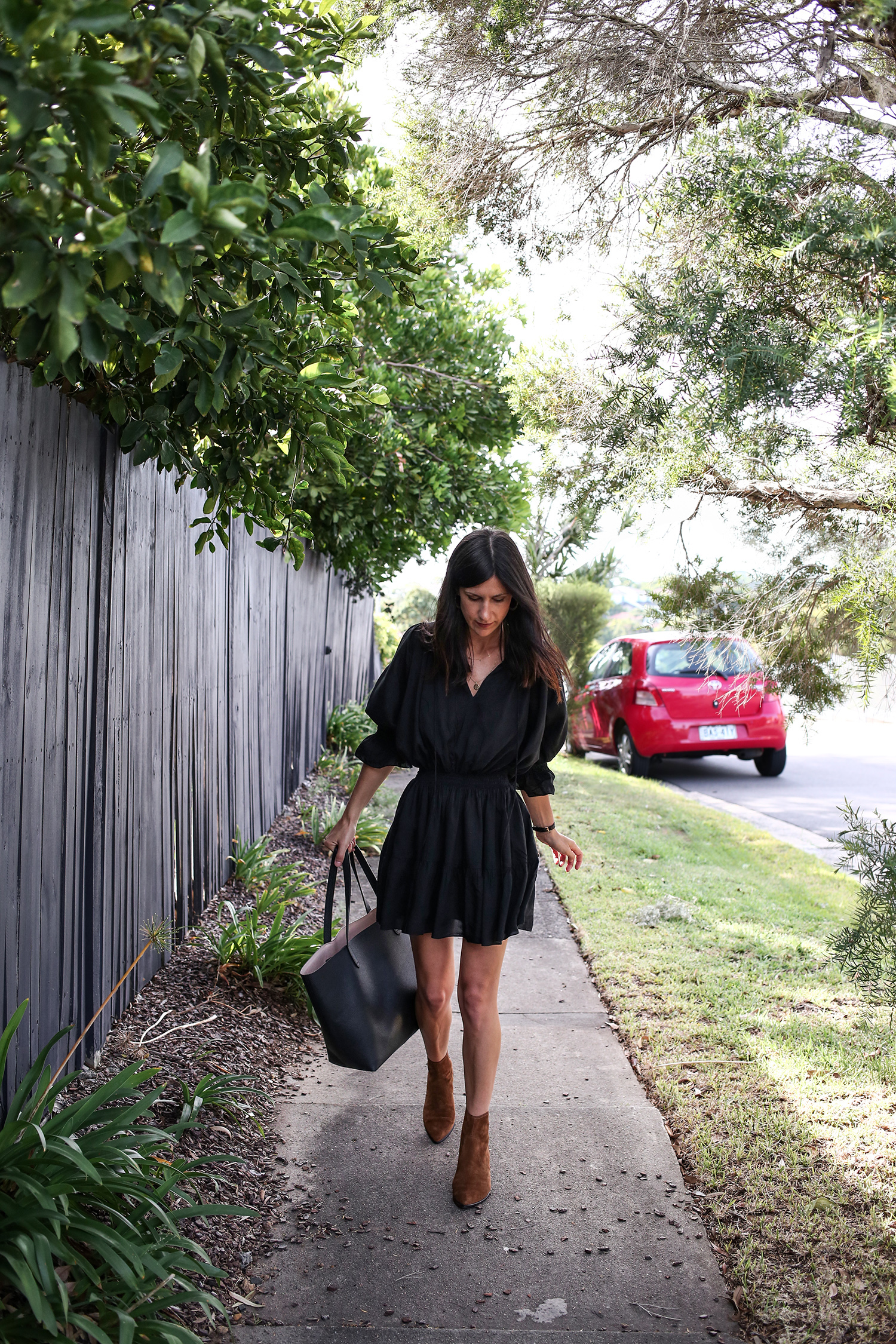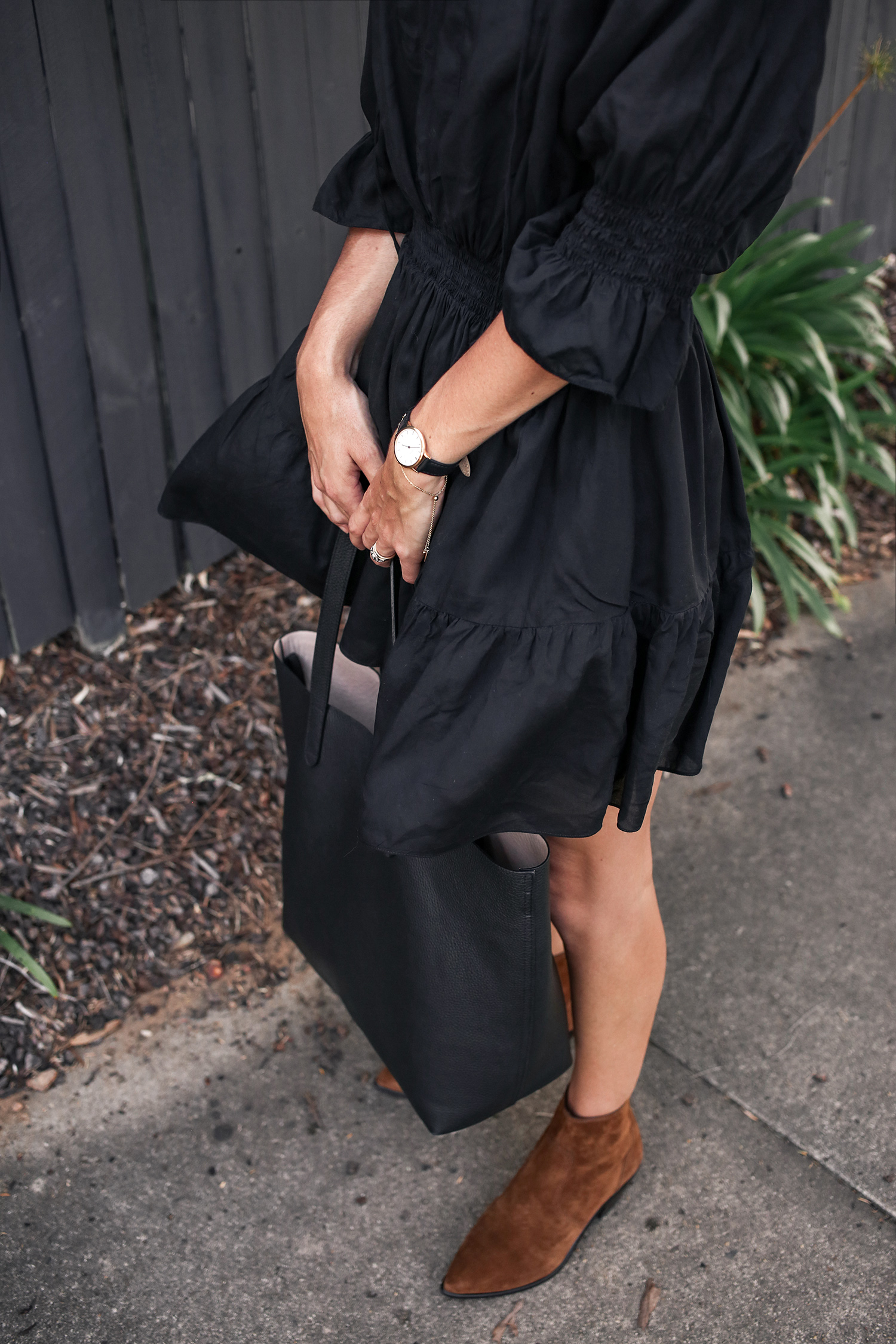

Vivienne Westwood said it best; ”Buy less, choose well”. It’s a mantra I’ve tried to instil in my attitudes towards buying new, as I continue to try and make informed, thought-out shopping decisions. Small changes in our habits compound over time, and I like to consider my own journey towards shopping more intentional a work in progress. The 5PFW Challenge has me thinking twice about buying trend pieces, multiples, or something new just because I feel like it. And my inclination to try and support ethical and/or sustainable designers where I can has made me scrutinise each new addition more than ever before. How many times will I wear this? Is it good quality? What about the potential environmental or social cost? Needless to say, these are things on my mind, and while I’m not making the perfect purchase each and every time, I am thinking more about how I’m using my purchasing power.
Wearing MLM Label dress, Loeffler Randall boots, Cuyana leather tote bag, Linjer watch, YCL Jewels necklace, Mejuri zodiac necklace
A lot of the time it can feel like you’re just a small cog in the machine, but how you choose to spend your money matters. I read recently that clothing is one of the only commodities which seems to decline in price each year – mind-boggling when you think about the actual costs associated with constructing a garment.
As a kid, most of my clothing was handmade by my Yiaya (much of which she’s hung onto!). I could have easily spent hours looking through pattern books searching for my next summer dress. We’d pick out the fabric, the buttons, and the zipper, and then my grandmother would sew the dress for me making a little bit of progress each day after work.
Despite not having the skills to sew myself, it taught me to appreciate the art of constructing a garment, and what to look for when shopping. Are the seams neat? Are the buttons tightly woven? Does the pattern line up at the seams?
How I choose to use my purchasing power is centred around three main pillars:
QUALITY
Whether it is high street or high end, quality is the first thing I look for. I’ve mentioned this before but you can find good quality at any price, it’s all about knowing what details you need to carefully inspect and consider.
Fabric composition is a big one for me, especially since moving to Sydney. Our winters are mild, and our summers tend to run hot and humid, so it’s important that what I do wear (particularly during the warmer months) is breathable. Primarily I look to garments made solely from natural fibres like silk, cotton, linen, wool or cashmere, or at least where they have a dominant percentage in the overall makeup of the piece. The fabric shouldn’t be itchy against my skin, and I’m generally open to fabric weight depending on how I plan to wear the item.
Seams must be evenly sewn, with no stitches loose, and I expect buttons to be sewn on tightly. The latter is simple to fix, however it can be frustrating to wear an item once only for a button to fall off.
Fit also falls into the quality pillar. Are the design details considered, or is it ill-fitting and poorly constructed? These are the kinds of things I like to think about when trying on the item.
ETHICAL & SUSTAINABLE PRACTICES
I’m pretty open about the fact that I’m no angel when it’s come to fast fashion in the past, and even now I’ll still make the odd purchase from retail giants like H&M, Topshop, Zara and ASOS. But, it’s worth noting that we we decide to shop and use our purchasing power says a lot. It’s the ripple effect from purchasing at ethical or sustainable retailers that has the potential to make waves.
Most of my new wardrobe additions are considered for at least 30 days before I go through with the purchase, which gives me enough time to research any suitable alternatives. I like to take into consideration the ethical and sustainable practices of the brands I am shopping from (where possible), and I use this to ultimately make an informed purchasing decision. Style and fit weigh heavily on my overall decision as these are things that can make or break whether an item is a worthwhile wardrobe addition or not. However having something in my wardrobe that has been made sustainably is always much more rewarding to wear than an item whose origins may be questionable.
Ethical or sustainable fashion by its very nature tends to be priced higher than fast fashion brands, so it can be out of reach for many with smaller budgets. In this instance, I think going the pre-loved route is also a great option if you want to try and shop in a more sustainable way, and often you can stumble across new with tags items for a very good price.
LONGEVITY
The final pillar that directs how I choose to use my purchasing power is longevity. This one is especially salient for me at the moment given the throwaway culture that seems to dominate the fashion landscape at the moment. Items shouldn’t be bought to be worn just once. While this doesn’t ring true of every wardrobe addition, the intent behind each purchase is that I’d like to wear it until it’s threadbare.
It’s here that I want to run a quick parallel between fast fashion and sustainable fashion. An item that was made sustainably, is just as unsustainable as buying a fast fashion piece if you only wear it once. If you end up wearing the fast fashion item until it is completely worn out, then that ends up being the more sustainable choice. This is why I will sometimes still choose to make a purchase from the likes of ASOS, and will continue to be open to my options in the months and years to come.
Perhaps worth noting is that some of my most worn and oldest items in my wardrobe are the ones that I splurged on. They were purchases from contemporary brands which were well-constructed and seemingly simple or classic in design, and are just as relevant today as they were the day I purchased them. While I don’t think a good investment piece needs to cost the earth, it does speak volumes about how price and quality are often correlated (although not always!).
How do you choose to use your purchasing power?


I don’t agree that a sustainably-made piece of clothing is as unsustainable as a fast fashion piece if you only wear it once. That overlooks how damaging fast fashion is from the materials used, manufacturing process, and the exploitation of workers.
It’s still a terrible waste, don’t get me wrong; however, the difference is the people who made the clothes were paid fairly, they have good working conditions, and the materials, resources, and processes aren’t as harmful to the earth. So no, a sustainable piece of clothing that’s only worn once and ‘thrown away’ is wasteful but it’s not as bad as a fast fashion piece.
When we continue to support brands who are abusing our planet and the people who make our clothes, we’re telling them we are OK with what they’re doing. They won’t change unless we force them to.
Author
I completely understand where you’re coming from – it’s a moral dilemma that I tend to struggle with a lot, especially being the kind of person who wants to be as inclusive as possible, and I’m highly conscious that ‘sustainable or ethical fashion’ does exclude those who are on lower incomes. Education is so important, and I think being aware is a huge step. I like to think of myself as a bit of a work in progress, but I try to continuously make steps towards positive change and not beat myself up when I make a misstep.
While I agree with you generally on the whole, it is worth noting that something being made sustainably (which relates more to environmental concerns), doesn’t necessarily mean it has been made ethically (relating more to social/moral concerns). While I’d like to assume that the two go hand in hand, it’s not always the case. The tragedies that have happened in Bangladesh (Rana Plaza in particular), and other countries where labour comes ‘cheap’, are inexcusable and I’m with you that more needs to be done. I’ve heard so many interviews with women who are employed in those types of factories, and one of the takeaways that has really stuck with me, is that if we were to just completely stop (globally) from shopping at these brands, it could potentially do more harm than good (especially if these women end up losing their jobs and only source of income). Perhaps I should have put a bit more time into writing this post to really explain where I’m coming from, but this is something I’m really passionate about, have read a lot about, and don’t make these considerations lightly. I’d be interested to hear your thoughts as I really value everything you have to say on your blog, but my own feeling is that there really needs to be institutional change, not only from those running these fast fashion labels, but also from a legislative standpoint in these countries where garment workers are being exploited. One thing I worry about is that regardless of what we try to change ourselves, this may be the only way that we will see real change and see these workers treated more fairly.
It’s incredibly depressing to consider this, but the reality is that any brand that is producing clothing at a large rate – whether sustainable or not – is doing damage to our planet. For me, the real answer is that we need to shop less. Buy more wisely, use what we already own. It’s a tricky balance, and one I’m still trying to figure out myself.
Thanks so much for weighing in Sophie – I really appreciate you sharing your point of view!
I completely agree with you on all points, in particular that we all need to just shop less. Thank you for such a thoughtful response!
This is very interesting to read. Thanks for your insight.
Could you tell us how you care for your clothes?